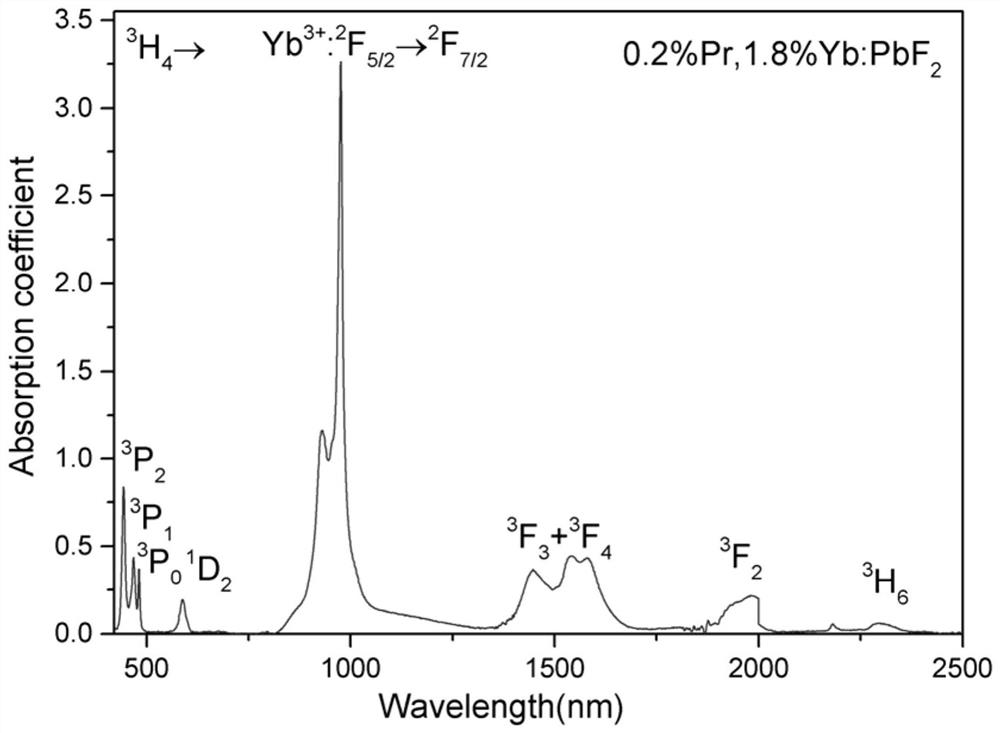Yb and Pr co-doped lead fluoride blue, green and near-infrared laser crystal and preparation method and application thereof
A technology of laser crystal and lead fluoride, which is applied in chemical instruments and methods, lasers, crystal growth, etc., can solve the problems of impracticality, lack of pump source, and laser output, etc., and achieve the effect of high blue light output power
- Summary
- Abstract
- Description
- Claims
- Application Information
AI Technical Summary
Problems solved by technology
Method used
Image
Examples
Embodiment 1
[0037] Growth of Pr by temperature gradient method 0.002 Yb 0.018 Pb 0.98 f 2 , specifically prepared by the following method:
[0038] Growth of Pr by temperature gradient method 0.002 Yb 0.018 Pb 0.98 f 2 Crystal, put 50g of raw material in a graphite crucible, vacuumize the furnace, fill in high-purity argon as a protective atmosphere, heat up to 840°C at a rate of 260°C / h, and keep the temperature for 10 hours until the raw material is completely melted and fully removed. , and then slowly cool down the melt at a rate of 1.5°C / h to grow. After the growth, the temperature was lowered to room temperature at 50°C / h, and then the crystal was taken out. Obtain a piece of Pr with good optical quality 0.002 Yb 0.018 Pb 0.98 f 2 crystals. It can be seen in the emission spectrum of the visible band that compared with the single-doped sample, the blue and green light have stronger emission, and the red light emission is significantly weakened, which can make the laser o...
Embodiment 2
[0044] Growth of Pr by temperature gradient method 0.003 Yb 0.025 Pb 0.972 f 2 , specifically prepared by the following method:
[0045] Growth of Pr by temperature gradient method 0.003 Yb 0.025 Pb 0.972 f 2 For crystal, put 50g of raw material in a graphite crucible, vacuumize the furnace, fill it with high-purity argon as a protective atmosphere, heat up to 840°C at a rate of 260°C / h, and keep the temperature constant for 10 hours until the raw material is completely melted and impurities are fully removed. Then, the temperature in the melt was lowered slowly at a rate of 1.5° C. / h to grow. After the growth, the temperature was lowered to room temperature at 50°C / h, and then the crystal was taken out. Obtain a piece of Pr with good optical quality 0.003 Yb 0.025 Pb 0.972 f 2 crystals. It can be seen in the emission spectrum of the visible band that compared with the single-doped sample, the blue and green light have stronger emission, and the red light emission...
Embodiment 3
[0047] Growth of Pr by temperature gradient method 0.001 Yb 0.01 Pb 0.989 f 2 Crystal, starting from PrF of 5N purity 3 ,YbF 3 and PbF 2 Single crystal grain or powder. After selecting a specific concentration of Pr ions and Yb ions doped to replace Pb ions, according to the chemical formula Pr 0.001 Yb 0.01 Pb 0.989 f 2 Calculate the mass required for each raw material and weigh it accurately, put the weighed raw material into a porous graphite crucible and cover it with a 2mm round graphite cover, vacuumize the furnace, and fill it with high-purity argon as a protective atmosphere The temperature was raised to 840°C at a rate of 260°C / h, and the temperature was kept constant for 10 hours until the raw material was completely melted and impurities were fully removed, and then the temperature in the melt was slowly cooled at a rate of 1.5°C / h to grow. After the growth, the temperature was lowered to room temperature at 50°C / h, and then the crystal was taken out.
PUM
 Login to View More
Login to View More Abstract
Description
Claims
Application Information
 Login to View More
Login to View More - R&D Engineer
- R&D Manager
- IP Professional
- Industry Leading Data Capabilities
- Powerful AI technology
- Patent DNA Extraction
Browse by: Latest US Patents, China's latest patents, Technical Efficacy Thesaurus, Application Domain, Technology Topic, Popular Technical Reports.
© 2024 PatSnap. All rights reserved.Legal|Privacy policy|Modern Slavery Act Transparency Statement|Sitemap|About US| Contact US: help@patsnap.com










